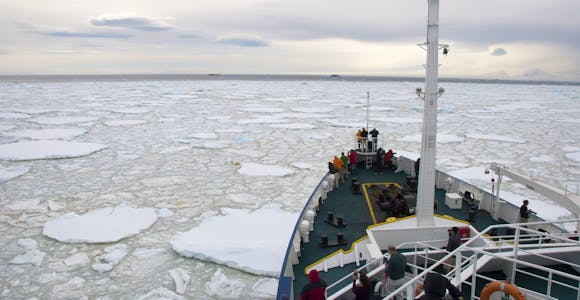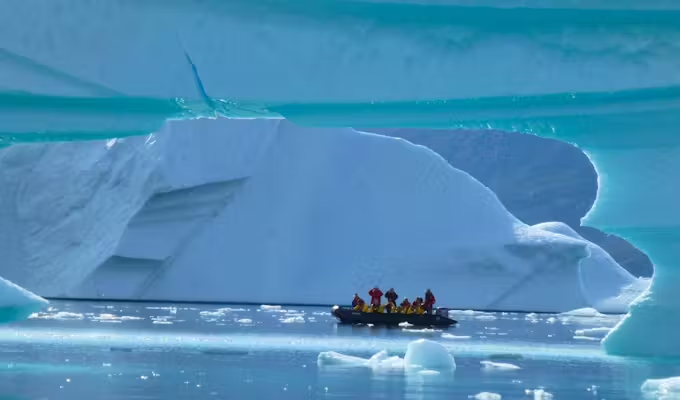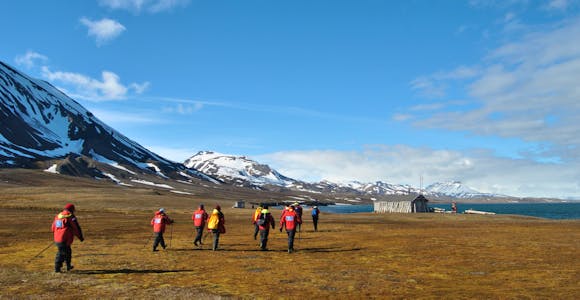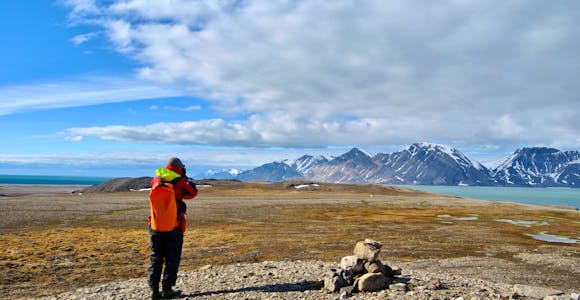
Svalbard Cruises
North of the Arctic Circle and halfway between Norway and the North Pole, Svalbard’s dramatic coastline and fjords are largely ice-free during high summer providing incredible …
Discover More
While Svalbard may be an almost year round destination, the changing weather, number of daylight hours, amount of ice and snow conditions through the year all have a marked effect on the activities available from one season to another.

In early spring as Svalbard begins to wake up from the long, dark winter, there is a twilight period characterised by an eerie, blue light. Temperatures are still fairly chilly, typically between -10 and -20 °C (14 to −4.0 °F).
This is the best time for snowmobiling and dog sledding across Svalbard’s pristine snowscapes, and subsequently, it's a busy time in Longyearbyen. As the season progresses, temperatures rise and days become longer, until the return of the Midnight Sun. By May, the coastal ice is breaking up allowing safe passage for the first ships of the season and the archipelago’s summer wildlife visitors - walrus, whales and breeding birds in their millions.
High summer in Svalbard is prime time for a Svalbard cruise. As summer progresses, new areas become accessible again as the ice melts, and walking the snow-free tundra is a real highlight. July is the warmest month, with average temperatures of 3 - 7 °C (37.4 - 44.6 °F).
The Midnight Sun’s constant daylight helps maximise wildlife sightings. Every cliff is packed with a frenzy of bird activity, whales return to the ice-free fjords, walrus collect in ‘haul-outs’ and opportunistic polar bears and arctic fox are on the prowl. By mid-July, ice-choked Hinlopen Strait between the islands of Spitsbergen and Nordaustlandet normally becomes navigable allowing circumnavigations of Spitsbergen.
.JPG?auto=format,enhance,compress&fit=crop&crop=entropy,faces,focalpoint&w=0&h=288&q=60)
Cruising through Svalbard ice
By the middle of September all expedition ships have left the archipelago. The weather is markedly deteriorating, and with dropping temperatures ice is beginning to reform. By October, Svalbard’s summer wildlife visitors have departed south, leaving Svalbard to settle back into its icy winter girdle.
The Polar Night - the period of 24 hours of darkness - has set in by November and Svalbard will remain cloaked in low light until mid-February. While the cold and darkness limits activity, it’s a great time to simply stay cosy indoors, looking out for the Northern Lights. During the winter temperatures can drop to between -20 and -30 °C (−4.0 °F) for sustained periods.

The Northern Lights dancing among the stars
Late May to August is prime time to explore Svalbard onboard an ice strengthened ship. The receding ice allows access for a few limited months each summer, combined with peak wildlife activity.

Maximise wildlife sightings with the chance to circumnavigate Spitsbergen island. Search for walrus, arctic fox, whales and of course the ‘King of The Arctic'. Sail through the Hinlopen Strait and visit abandoned trapping stations and experience glaciers up close all…

Introductions to the High Arctic don’t come much better. Traverse the High Arctic between wildlife-rich Svalbard, via East Greenland’s towering icebergs and autumnal tundra then onto Iceland. Aurora sightings are possible at any point. The longer trip also includes Jan…

This early season Svalbard voyage is a ‘classic’ providing ample time for near guaranteed polar bear sightings, alongside encounters with the region’s other plentiful wildlife and exploring its dramatic scenery. Phippsoya, 14th of July glacier and Hinlopen Strait are all…

Travelling at the height of summer this 14-day trip is the longest of any Svalbard cruise - providing the best possible conditions for wildlife encounters. This circumnavigation of Spitsbergen includes huge glaciers, bird cliffs and ice choked channels. There's even…

Truly escape the modern world and explore Svalbard onboard a schooner. Sail north through the melting spring ice, spot wildlife and learn about the archipelago’s rich history. Highlights include the Monaco Glacier, 17th century whaling settlements, close encounters with megafauna…
Wildlife activity reaches its peak on Svalbard during high summer - June, July & August - making these months the best time to travel for wildlife enthusiasts.
The term used to describes the phenomenon of 24-hour daylight, the Midnight Sun is experienced on Svalbard from 15th April to 26th August each year.
Flights from Oslo take 3 hours and may stop in Tromso en route.
Not for Svalbard itself, but as you will be travelling through Norway non-EU nationals should check what the visa requirements for that country are.

North of the Arctic Circle and halfway between Norway and the North Pole, Svalbard’s dramatic coastline and fjords are largely ice-free during high summer providing incredible …
Discover More
Svalbard is geographically closer to the North Pole than to Norway. Surprising then, that getting there is quite so straightforward, with regular flights from Norway to …
Discover More_(3).jpg?auto=format,enhance,compress&fit=crop&crop=entropy,faces,focalpoint&w=580&h=300)
The largest and only permanently populated of Svalbard’s islands, Spitsbergen is where all the activity and life happens. The beating heart of Spitsbergen itself is the town of …
Discover More
We're all clear on where the Arctic is located and why we want to visit, but its vastness and the sheer variety of experiences on offer can be a real challenge when deciding where …
Discover MoreWe'll spend some time listening to your aspirations, then discuss the kind of experience that might suit you.
Next we'll discuss the options, shortlist the best trips for you and present you our impartial recommendations.
We'll place a 24 hour hold on your preferred option - without obligation - whilst we talk through the details.
Our team of experts are ready to help you with any questions about a trip to the Arctic.
This website uses cookies to ensure you get the best experience on our website. Privacy policy